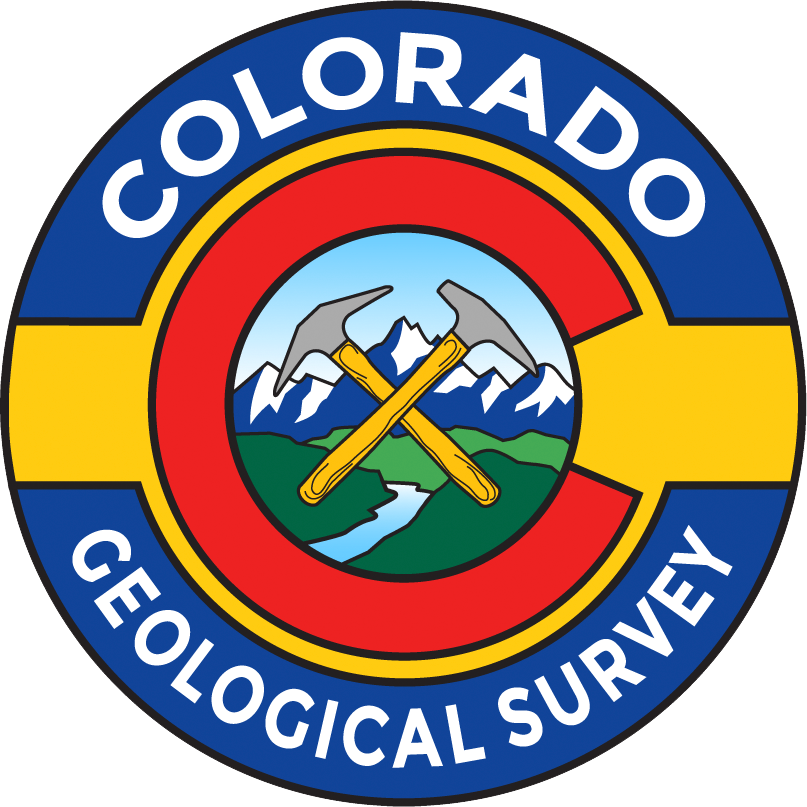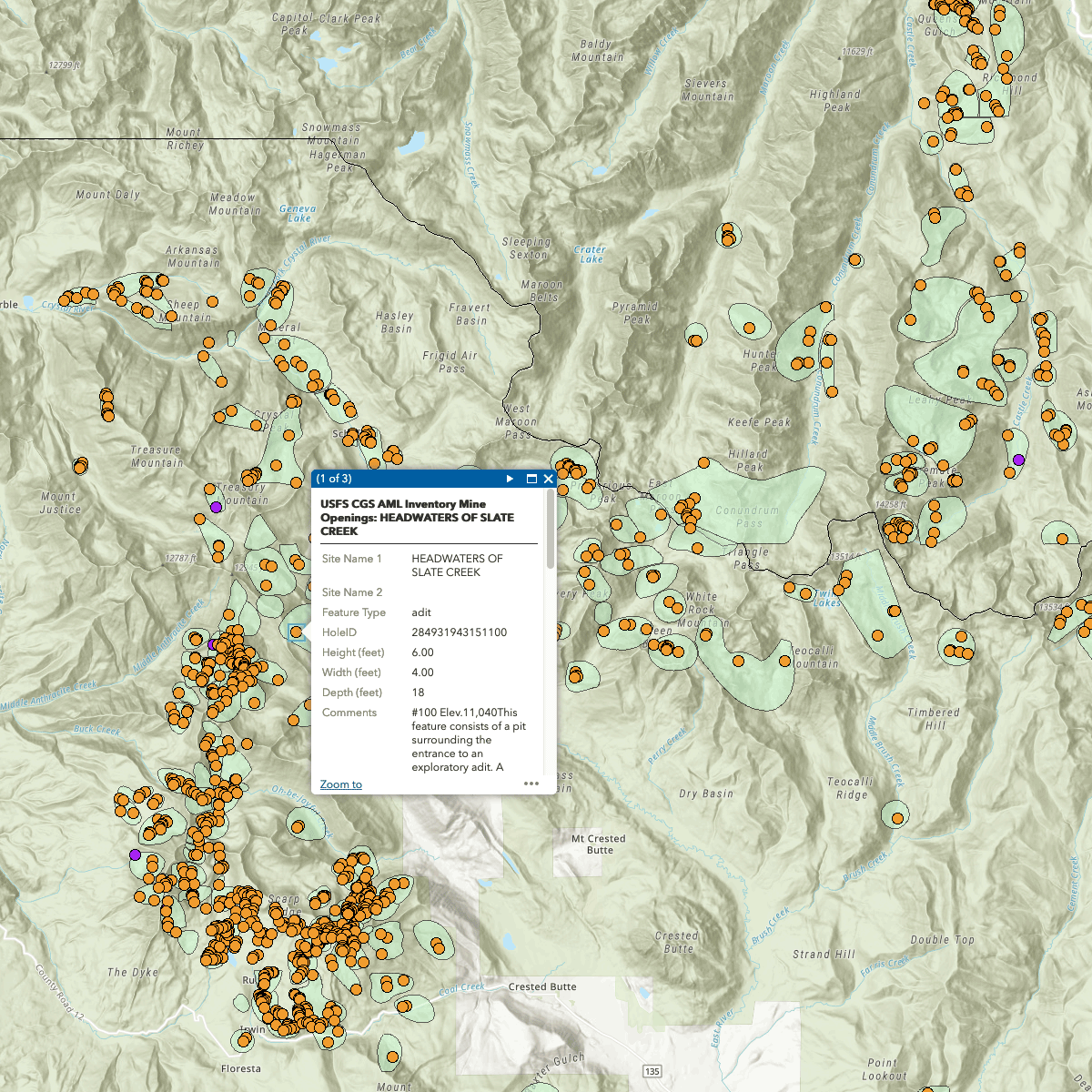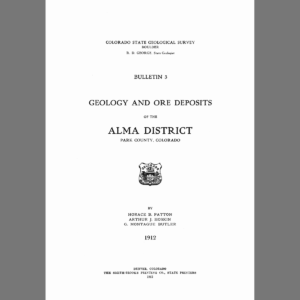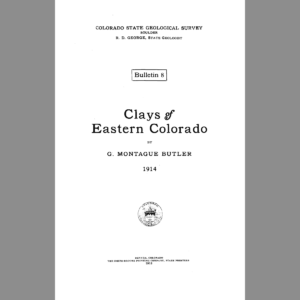Description
This is the most current downloadable data package for this historic project and is comprised of GIS data collected in the 1990s; finalized as of 03 June 2011; with minor clerical updates completed as of 20 August 2020. For more information on abandoned mines in Colorado, see OF‐19‐12 Colorado Abandoned Mine Land Inventory and Information Hub: Report on the Development and Data Sources. Digital ZIP/GIS/PDF download. ON-008-04D – v20200820
Included in this ZIP package:
— ON-008-04D-Read_Me.pdf
— ON-008-04D National Forest Reports.pdf — Compilation of numerous individual Ranger District field reports, organized by National Forest, summarizing sites of particular concern in each applicable ranger district
— ON-008-04D Project Documents.pdf — Includes a Field Guide providing general guidelines for the field geologist gathering AML data, sample USFS AML Field Data Form, and a Data Dictionary
— GIS_Data folder — Contains geodatabase files and metadata on the provenance and methodology.
This GIS dataset presents a broad set of abandoned mine features identified on Colorado U.S. Forest Service lands between 1991 and 1998. It does not represent all abandoned mine features on these lands nor within the State. Spatial information has varying levels of accuracy due to the various methods of data collection. Information presented on this site may change and be updated. Exact physical locations are estimated and the abandoned mine features are not visible when zoomed in to a specific location. The observations presented here represent a snap-shot of site conditions from site visits made between 20 and 30 years ago. The conditions at each site may have changed and/or the U.S. Forest Service may have worked at the site since these data were collected. Questions about specific abandoned mine features should be directed to the U.S. Forest Service or the Colorado Division of Mining, Reclamation and Safety (DRMS). The DRMS Inactive Mine Reclamation Program (IMRP) addresses hazards and environmental problems associated with abandoned or inactive “legacy” mines in Colorado.
To the accompanying online GIS map of this dataset: ON-008-04M U.S. Forest Service Abandoned Mine Land Inventory Map – Colorado
NOTE: The data presented here are not intended to be used as a tool to assess risk. ANY DATA OR INFORMATION PROVIDED HERE IS PROVIDED “AS IS” WITHOUT WARRANTY OF ANY KIND, WHETHER EXPRESS OR IMPLIED, INCLUDING, BUT NOT LIMITED TO, THE IMPLIED WARRANTIES OF MERCHANTABILITY AND FITNESS FOR A PARTICULAR PURPOSE. Data or information provided here shall be used and replied upon only at the user’s sole risk, and the user agrees to indemnify and hold harmless the entities who provided the data and any other parties, its officials, officers and employees from any liability arising out of the use of the data/information provided. No warranty expressed or implied is made regarding the display or utility of the data, or for general or scientific purposes, nor shall the act of distribution constitute any such warranty. The Colorado Geological Survey and U.S. Forest Service shall not be held liable for improper or incorrect use of the data described and/or contained herein.
General Project Description
The CGS completed an inventory of environmental degradation associated with abandoned and inactive mines on National Forest System lands in Colorado during the years 1991 through 1999. In the course of the Abandoned Mine Land Inventory (AMLI) project, areas with natural acid rock drainage were also noted. Approximately 18,000 abandoned mine-related features were inventoried, including about 900 features that are considered significant enough environmental problems to warrant further investigation. Water quality data, such as pH and conductivity were gathered at all features where water was present, such as draining adits, seepage at the toe of dumps and tailings, and standing water in shafts. Water samples were taken where field tests indicated low pH and/or high conductivity, including several areas with natural acid rock drainage. Samples were analyzed for dissolved and total metals, and for selected anions. All mine locations and data collected by the field geologists were entered on field forms and, subsequently, into a computer database and GIS format.
With the information provided by the inventory, the U.S. Forest Service (USFS), in cooperation with other agencies, has been able to prioritize abandoned mines for reclamation. In most cases, cleanup is approached on a watershed basis. Mines in priority watersheds were selected for reclamation first. Watershed studies and mine cleanup are taking place or have been completed in the upper Animas River, Willow Creek (tributary to the upper Rio Grande), Chalk Creek (tributary to the upper Arkansas River), the upper Snake River, the Uncompahgre River, the Alamosa River, and additional Colorado watersheds. During the inventory, evidence of natural water quality degradation was found in areas where little or no evidence of mining activity exists. These areas include the upper Alamosa River, the Middle Fork of Mineral Creek, Peekaboo Gulch, Handcart Gulch, and elsewhere. Water from natural sources has been found to exceed Colorado water quality standards significantly for several metals in these areas and must be considered in reclamation decisions and remedial activities.





